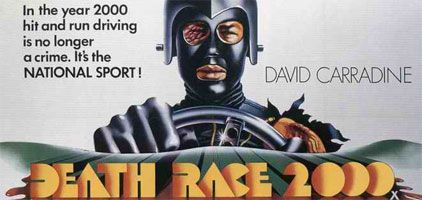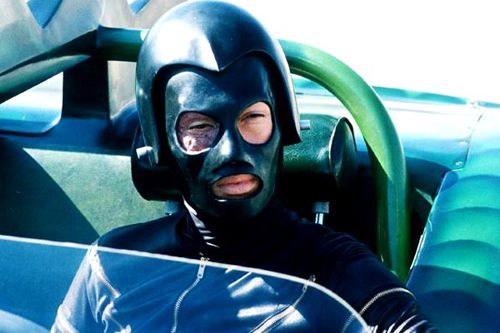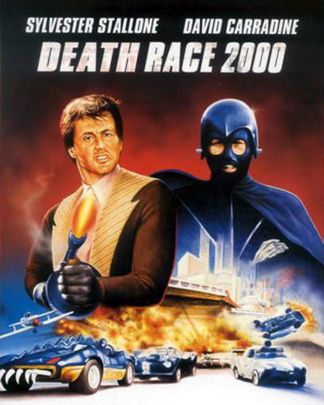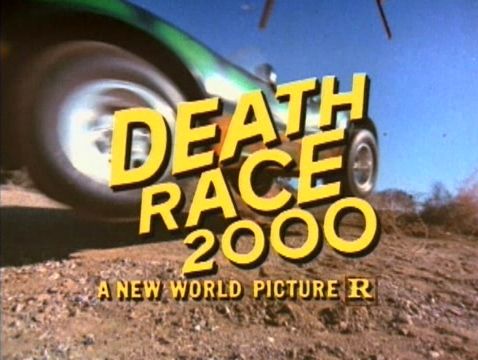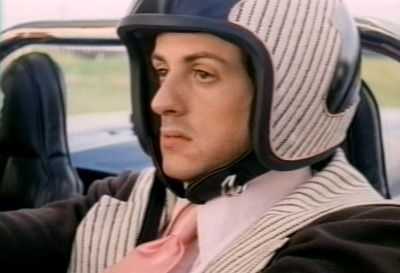Death Race 2000 is the real deal. A truly epic piece of Roger Corman produced madness, full of blood, guts, ridiculous character names, car crashes, and of course those wonderful, pre-plastic surgery era gratuitous nipple shots.* But what makes Death Race 2000 stand out from say, Gone in 60 Seconds, is that it’s more than just the above elements. Underneath the slapstick gore and voyeuristic charms Death Race 2000 is also a sly social and political satire that is every bit as prescient as Network or Robocop. More after the jump:
The film is set in a not-too-distant future (now the past) where culture has eroded to the point where the biggest national sport is a cross country race wherein the drivers are encouraged to hit pedestrians and try to kill one another, (The writers obviously never imagined non-game shows like Deal or No Deal.) We follow the racers as they make their trek and slowly discover a larger conspiracy tied to David Carradine’s Dr. Frankenstein and Sylvester Stallone’s Machine Gun Joe Vertibo.
The movie has aged remarkably well in large part because Stallone went on to become Rocky and Carradine went on to become Bill. Watching the film today, there is an extra layer of intrigue because we’ve been trained to see Stallone as a hero and in his later roles, Carradine began to play the villain. Consequently, upon first viewing one is actually surprised by the turn of events.
And the movie has other surprises too. The opening musical montage is all American, vaguely recalling Robert Altman’s Nashville, until you see a race fan mindless waving a Swastika flag in between mouthfuls of popcorn and cola. And the whole film operates like this, it’s good satire because all of the elements are begin as bland middleclass bourgeois activities and end with something like a holocaust joke. But you know, a good holocaust joke.
Most of the runtime is made up of four elements: racing set-pieces where undercranked cameras capture ridiculous, Wacky Racers-esque cars duking it out on the road, gory inserts of pedestrian murders, expository details told directly to the audience by Hedda Hopper style infotainment journalists, and the aforementioned conspiracy subplot. It’s a bit thin at a point with so much of the story being told rather than shown, but the color commentators add enough color so as to hide the somewhat shoddy structuring, plus it’s thematically resonant.
Several early scenes are dedicated to explaining the rules of the race directly to the audience, but they never really make any sense. How exactly do the scorekeepers know how hold the pedestrians are? Moreover, if it’s a race, why do all of the characters end each day at the exact same location? Perhaps it’s a rally, perhaps it’s not a race at all but rather a contest about how many civilians can be killed and the name “race” is just for pizzazz. I suppose it could be a subtle jab at media manipulation, it’s certainly no more patently absurd than the idea that America would choose a different easily marketable niche as the winner of American Idol every year for nine years running.
And just as every American Idol winner has an obvious marketing gimmick, each of the different racers also has a signature style. There is the cowboy car, the nazi car, the gangster car, the Greco-Roman car. And the driver of each vehicle is linked to this persona. The Grecco-Roman car is filled with grapes and the male co-driver is a bit of a…er…”boylover”. The cowboy (actually cowgirl) car is full of rootin’-tootin’ gunplay and double entendre. Everyone has their own slang and style, and even if it is generally on the nose, it’s also charming.
The car crashes and kill scenes swerve between brilliant and predictable and things lag a bit in the third act because, as Corman readily admits several of the disc’s interviews, they had no idea how to end the movie, but there is still a wonderful anarchic punch to the proceedings.
Make no mistake, Death Race 2000 is not some Citizen Kane of exploitation cinema. It’s a cheapie 300k picture full of plastic costumes and cardboard sets that brought on a second unit director to add gore and tits when the original helmer balked. It’s silly, sloppy, and sometimes incoherent, but it’s also a lot of fun and it has a real idea at its core.
THE DVD:
This latest edition of Death Race 2000 comes loaded with all the special features of every previous edition, plus a nice little 12 page booklet and a couple of new features.
It must be noted that the DVD case brags about a new high-def transfer in 1.85:1, this is a selling point I suppose, but it’s actually a problem because several sources say that the movie was shot in 1.33:1 and released in 1.78:1. I’m not a technicals nerd, but it strikes me as odd that they would release a DVD in 1.85:1 when the intended ratio is actually the same as a 16:9, you know…the exact format of an HDTV. That said, I watched the movie on my MacBook Pro matte screen laptop and noticed no stretching or distortion.
There are 2 separate commentary tracks, an older one with Corman and actress Mary Woronov and a new one with Assistant Director Lewis Teague and editor Tina Hirsh.
Corman has this great warm voice and he tells a lot of great anecdotes, meanwhile Woronov seems to feel uncomfortable with the film and a little ashamed to be participating.
The new track might seem to be scraping the bottom of the barrel (I’ve never seen a commentary track from an AD before), but it actually makes sense in context. Paul Bartel, now deceased, refused to shoot any of the gory scenes for the movie so Teague was brought on to punch it up. As such, his contribution and his insight are more pertinent than they might initially appear.
Both tracks are a bit dry at times and there are some gaps of silence, to say nothing of the information that is repeated five or six times across all of the commentaries and interviews, but it’s still nice to have. All in all, The Corman track, is vastly superior to the new one.
Additionally, there is a 12 minute interview with Ib Melchoir, author of the original short story on which this film is based. It’s nice to see the original creator getting some love, and Melchoir certainly has some interesting anecdotes, but the whole piece feels rather long with Melchoir repeating information two or three times over. And then he gets into his writing method, a method that includes radical ideas like, “every story should have a little bit of conflict to push it forward.” William Goldman he is not. Making matters worse is the hilariously out of place classical music inserted into the background at random. It also struck me as kind of sad that Melchoir goes out of his way to explain what a great guy Corman is for…following through on the most basic commitments of his story option agreement.
Fairing better are the featured interviews with Corman and the late David Carradine. The Carradine interview is a nice touch and basically essential considering how closely timed to his actual passing this disc is, but it’s still a bit light and fluffy. Meanwhile, Corman’s interview is actually rather insightful and deals with the practicalities of independent production in the modern era. It would have been better if they got someone other than Leonard Maltin, who sits in front of a Piranha poster in full prom night blowjob mode, but it is what it is.
The rest of the features are kind of filler. We get shorts about the score, the costumes, and the car and set designs, which the DVD refers to as “legendary.” The problem here is, excepting the occasionally iconic cars, the sets, costumes, and especially score are all terrible, a fact which the cast and crew openly discuss in other portions of the disc. It’s nice to see some of the early car design stuff, but otherwise, I can’t imagine anyone really needing this matieral.
Perhaps the most interesting thing about this set is Corman. We see him at three or four different stages in his life and we see him telling the same stories three or four different times. His perspective chances slightly and he’s more honest on the newer docs, but the man is a true showman. If you pay attention you’ll notice that he uses almost exactly the same words to describe events in the “looking back” documentary as he does in his commentary track, which in turn are almost the exact same words he used in his Maltin interview. Something tells me if we were to look up the press notes from the initial release, it might match those too. To some, this repetition might be irksome, but to me it was educational. It’s like Glengarry Glen Ross, man. Always be closing.
CONCLUSION:
I like Death Race 2000. It’s a really fun film and it has twin great performances from Stallone and Carradine. Looking at the film with fresh eyes, you even get a nice little twist because you’re not sure who the heavy is immediately. Also, the film packs a sharp satirical punch.
However, the DVD is a bit underwhelming. The new transfer is (I think, if I’m wrong please correct me in the comments) in the wrong aspect ratio and most of the other features are repackaged or simply lackluster, though the various versions of Corman shown do give us some unintended insight into his character and methodology.
Furthermore, the DVD packaging strikes me as crass. If you sell something as a “cult classic” it ceases to be one. It has to be organic; it’s the difference between The Rocky Horror Picture Show and Shock Treatment. Along with this, a crisp clean copy of the film is all well and good, but Corman literally intended it to be shown on scuffed up prints in front of dirty projectors, that way you couldn’t see the often-shoddy production value. Consequently, my three-dollar version of the film is actually more inviting, even if the colors are truer in this edition.
THE MOVIE: B+
THE DVD: C+
*Which, by the by, are some of the best I have ever seen, excepting the last twenty minutes of The Kentucky Fried Movie.

